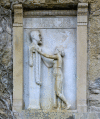Robert Koch, malaria pioneer
- PMID: 35813270
- PMCID: PMC9242531
Robert Koch, malaria pioneer
Abstract
The role of Robert Koch in the early discoveries of the malaria lifecycle and the complex of diseases, the development of immunity, quinine prophylaxis and the mosquito theory has fallen into oblivion. As a mature and famous hygienist, Koch had travelled the Old World, where malaria was endemic. His first studies took place in Tanganyika, German East Africa (now Tanzania) in 1898 and thereafter in Italy and the East Asian archipelago. As malaria in Germany did not offer a sufficiently endemic situation, he chose the Istrian island of Brioni (Kroatia) to eliminate malaria. Because virtually all of Koch's publications are in German, his achievements on malaria never settled in the common memory of tropical medicine. Around the turn of the century the race to elucidate the transmission pathway through mosquitoes took place and though he hardly yielded any honour of priority, his research certainly determined the speed by which British and Italian contenders made their ways. His exertion and interference led to the awarding of the 2nd Nobel Prize in Medicine to Ronald Ross only, leaving Giovanni Battista Grassi to draw the blank. Proof of this intervention in the otherwise well-known quarrel at the start of modern malaria research shows once more how personal characters may clash or join forces.
Copyright © 2022 Verhave.
Conflict of interest statement
The author declares no competing interests.
Figures







References
-
- Verhave JP. Immunization with sporozoites. An experimental study of Plasmodium berghei malaria. 1975. PhD thesis, Radboud University Nijmegen,
-
- Verhave JP. The Moses of Malaria. Nicolaas H. Swellengrebel (1885-1970) abroad and at home. 2011. Rotterdam, Erasmus Publishing,
- A Constant State of Emergency. Paul de Kruif, Microbe Hunter and Health Activist. Holland MI: Van Raalte Press; 2020.
-
- I easily read German. American science historian Dr. Hermione Giffard has screened the present text and commented on the organisational style of the presentation.
-
- Schnöpf M. Robert Koch und die Malariaforschung, Magisterarbeit Freie Universität Berlin; 2001.
-
- Koch R. Reise-Berichte über Rinderpest, Bubonenpest in Indien und Afrika, Tsetse- oder Surrakrankheit, Texasfieber, tropische Malaria, Schwartzwasserfieber. Verlag Julius Springer; Berlin: 1898. pp. 93–133.
- Koch R. Ärtzliche Beobachtungen in den Tropen. Deutsche med. Wochenschr. 1898;24:326–343.
- (also separately published: Verlag Dietrich Reimer, Berlin 1898).
LinkOut - more resources
Full Text Sources
Research Materials
